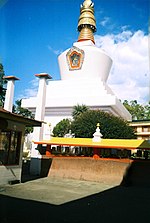Portal:India/Today's selected article/January 11, 2007
| This page is currently inactive and is retained for historical reference. Either the page is no longer relevant or consensus on its purpose has become unclear. To revive discussion, seek broader input via a forum such as the village pump. |
| This page is currently inactive and is retained for historical reference. Either the page is no longer relevant or consensus on its purpose has become unclear. To revive discussion, seek broader input via a forum such as the village pump. |
Gangtok is the capital and largest town of the Indian state of Sikkim. It is situated in the lower Himalayas. Known for its clean surroundings and temperate climate, this hill station of about fifty thousand people is the centre of Sikkim's tourist industry. Gangtok was a small hamlet until the construction of the Enchey Monastery in 1840 made it a pilgrimage center. It became a major stopover between Tibet and British India at the end of the 19th century. Following India's independence in 1947, Sikkim became a nation-state with Gangtok as its capital. In 1975 the monarchy was abrogated and Sikkim became India's twenty-second state, with Gangtok remaining as its capital. City is also a centre of Tibetan Buddhist culture and learning with numerous monasteries and religious educational institutions. Gangtok is connected to the rest of India by an all-weather metalled highway, NH-31A, which links Gangtok to Siliguri. The civic infrastructure of Gangtok is overseen by the local municipal corporation whose councillors are directly elected by the people. The rural roads around Gangtok however, are maintained by the Border Roads Organisation, which is a part of the Indian army. (more...)
Recently appeared: Sardar Vallabhbhai Patel – History of Buddhism – Ladakh

